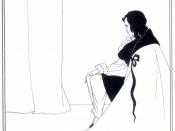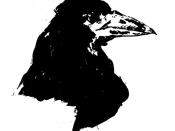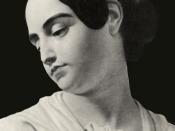"Behind the women in Poe's life and those he created in his stories glows always Elizabeth Poe's [his mother] pale beauty idealized; and the terrible sickness which infused it became the thrilling and dangerous, but romantic and essential, compassion of love." --Wolf Mankowitz
Edgar Allan Poe has shocked and intrigued his audience since his days at the University of Virginia. He defined the American horror story with his tales of revenge, murder, and spirits who return to the mortal world. Despite the unpredictability of Poe's works, how with every page a new horror arises, there is a predictable and prevailing theme in many of his short stories and poems -the dependence of male a character on a woman and the eventual illness and death of that woman. This theme is so strong in all of Poe's works, that we must assume that it has some close connection to his own story, and his history of relationships with women.
Imagine a woman in the early 19th century. She has dark curly hair, huge dark eyes, and pale skin. She is wearing a shimmering gown with flowers in her hair and gossamer wings on her back. Now, think of this image through the eyes of a child, two or three years old, who watches this women from the front row in a theatre every night, as she plays a spirit in a mysterious new land. The next night, as that child sits in his same seat, the woman is transformed into Juliet, and stabs herself. Night after night the blood pours from her chest, the audience members weep, and after the curtains close, the bloodstained Juliet carries her son home and puts him to bed (Mankowitz 17).
This was the young Edgar Poe's experience of his mother, Elizabeth Poe. Along with the magic that surrounded her fairy's wings and repeated resurrection, was the love and tenderness that she showed to Edgar, and the resulting selfishness he felt for her (14). When his mother finally died for the last time, from pneumonia when he was a month shy of three, Edgar was given into the care of Mrs. Allan, the barren wife of a wealthy merchant (who was not particularly fond of the idea of adoption). Just like Poe's own mother had been, his foster mother was hopelessly devoted to pleasing him, and he became hopelessly addicted to her love (20-23). Through his adolescence Poe fell deeply in love with and became dependant on many mother figures--first his mother, then Mrs. Allan his foster mother, and finally, the mother of a friend, Mrs. Standard. Along with these relationships were fleeting romances with girls his own age while in school -all who were more like muses to him than loves, inspiring his first poems (29). Before he was twenty-one, Poe had lost all three of these most important women in his life, was feeling lost, and was rejected by his foster father and new foster-step-mother.
Now we have Edgar, out of his unloving foster father's home, living with an aunt and her daughter Virginia, and trying to make a name for himself as a magazine editor (Wilson). When he is 27, Poe marries his 13-year-old cousin (although the marriage certificate declares Virginia to be "of the full age of twenty-one years")(Mankowitz 113). Within two years of their marriage, Poe begins to write his most famous and disturbing stories, beginning with "Ligeia" and "The Fall of the House of Usher". It seems likely that Poe's love for Virginia and their marriage could have unearthed the feelings of loss for his mother, foster mother, and Mrs. Standard, these feelings are obviously evident in these first of his most popular stories.
In "Ligeia," we see the narrator hopelessly in love, devoted, and dependant on his female love-interest. When Ligeia dies, of consumption just as every other woman in Poe's life, the narrator's desperation for her return is so strong that he "tries to resurrect her through the body of Rowena, because he cannot survive without the powerful Ligeia, for she provides him with strength, vitality, and knowledge" (Verrone 52). This story exemplifies Poe's fear of again losing a woman whom he loves so dearly and the disorder in his life that would soon follow.
This fragility and dependence on women is transferred to yet another male character in "The Fall of the House of Usher." In this story, Roderick Usher is desperately dependant on his twin sister, Madeline, who is, of course, stricken with a terminal illness. The relationship between Roderick and Madeline is just as if they were in love, much like the love between Poe and his cousin (Rowlett). Without Madeline, Roderick will be lost, alone, and the last of his family. In the end, Roderick mistakenly locks his sister away in a tomb while she still lives (although somehow the signs of life, such as flushed cheeks, were overlooked during the burial.) When Madeline finally escapes, the shock of her return kills her brother, she dies from the strain of escaping her tomb, and the narrator (a house guest) flees the ancient home just as it is crumbling. Again we have the idea that Poe's life is balanced only by the love, companionship, and support of women, specifically his wife.
In 1842 the downward spiral of Virginia's health begins. While singing, she breaks a blood vessel in her lung and eventually it is discovered that she has tuberculosis (Mankowitz 140). Over the next four years Poe drinks heavily and writes his most famous works; "The Tell-Tale Heart," "The Pit and the Pendulum," "The Cask of Amontillado," and maybe his best know work, "The Raven." In "The Raven" we are most strongly aware of Poe's ties to a woman (actually, several women), who have died or are out of his reach. The narrator repeatedly asks the raven (hoping that it is a supernatural messenger) if he will ever reclaim his lost love, Lenore. The bird's only reply to the narrator's demanding inquiry is "nevermore," which can be interpreted as the bird's refusal (or inability) to answer (Freedman 146), or simply as the bird saying "you will never be reunited." Either way the point gets across that the narrator has lost his love(s) forever. The reader can clearly see from this work an image of Poe, lost in his drunkenness and alone with his writing, lamenting over the losses he has incurred and reaching for a means to keep Virginia from slipping away.
Despite the anguish that Poe felt for Virginia decline and despite the many loves he had already lost, fate had it that Virginia would die just as all of the other women whom Poe had loved. In January of 1847 Poe would suffer his last loss as his wife died from tuberculosis; and how fitting that the only woman who Poe could truly call his own, had her only portrait painted as she lay in her deathbed, minutes after her last breath was given (Mankowitz206). Weeks before Virginia's death, Poe writes a story that delves deeper into his feelings of helplessness and guilt for Virginia's condition. In "The Oval Portrait," the narrator reads an account of how a strikingly life-like portrait came to be. The painter of the portrait is obviously a direct reflection of Poe himself. As David Grantz writes in his thesis, "Poe's use of a painter rather than a writer thinly veils its autobiographical portent." And, in fact, the painter's vigorous obsession with this portrait of his wife (who is much younger than himself) leads to the death of his love. It is as if the painter has drawn the actual life out of the young woman and put it onto his canvas. Poe feels guilty at this point in his life for the inevitable death of Virginia and for his inability to provide for his family because of his absorption in his writing and other selfish affairs (Grantz). In this, the last of Poe's great gothic stories, he finally confesses his dependency on women through an almost direct description of his life. He feels that his own weakness, fragility, and dependence has, in fact, drawn the very life out of the women he so loved and needed.
Less than two years after Virginia's death a daguerreotype of Poe was taken in Rhode Island. One of his friends then, Mrs. Sarah Helen Whitman, believed the picture showed Poe "immediately after being snatched back from the ultimate world's end of horror" (Mankowitz 225). But Poe's life had recently come crashing down around him and was soon to end; this disturbed, fragile, and mysterious man had lived his whole life in a haze of horror and dependency. He only survived through the support of a woman and his attachment was so that he could not bear to live without the women he loved.
Today, a mind like Poe's would have been rooted out of society early in his teens, subjected to psychotherapy, and he never would have written so many tense, horrific stories of women with strong spirits and fragile health and the weak men who depend on their life so deeply. Perhaps with the psychology of today and mental help early on in his life, Poe would have been able to lead a full, normal, and happy life. However, some would say that fate has a hand in everything and Edgar Allan Poe was destined to lead a life that inspired stories which people refrain from reading alone on dark, stormy nights.
Works Cited
Freedman, William. "Poe's THE RAVEN." Explicator 57:3 (1999): 146-149.
Grantz, David. The Stricken Eagle: Women In Poe. 20 April 2001. 3 July 2001.
Mankowitz, Wolf. The Extraordinary Mr. Poe. New York: Summit Books. 1978.
Rowlett, Douglas and Linda. "The Fall of the House of Usher- Madeline." 2 October 1997.
3 July 2001.
Wilson, James Southall. "A Summary of Facts Know about Edgar Allan Poe." July 1999. 29
June 2001.
Verrone, William Edward Bullard. The Role of the Feminine in Selected Works of Edgar
Allan Poe. Western Carolina University. 1995.


